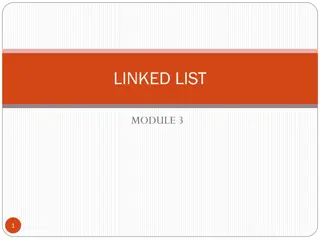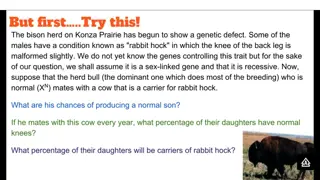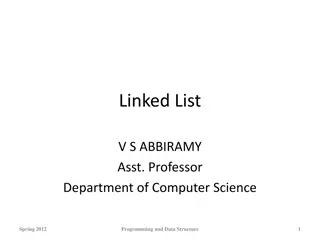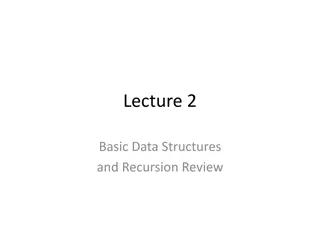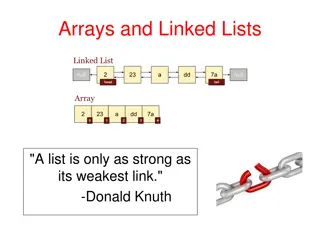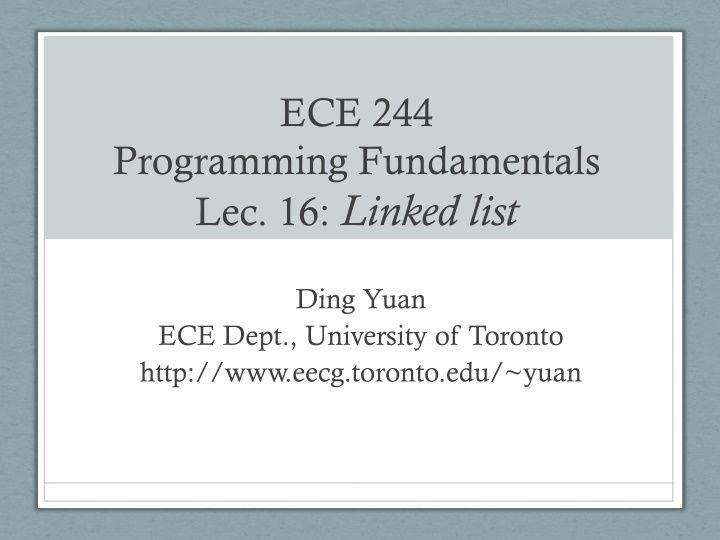
Linked List Implementation in Programming Fundamentals
"Learn about designing programs and organizing data using linked lists, a fundamental data structure. Explore the concepts behind linked lists and how to implement and work with them efficiently in your programming projects." (247 characters)
Download Presentation

Please find below an Image/Link to download the presentation.
The content on the website is provided AS IS for your information and personal use only. It may not be sold, licensed, or shared on other websites without obtaining consent from the author. If you encounter any issues during the download, it is possible that the publisher has removed the file from their server.
You are allowed to download the files provided on this website for personal or commercial use, subject to the condition that they are used lawfully. All files are the property of their respective owners.
The content on the website is provided AS IS for your information and personal use only. It may not be sold, licensed, or shared on other websites without obtaining consent from the author.
E N D
Presentation Transcript
ECE 244 Programming Fundamentals Lec. 16: Linked list Ding Yuan ECE Dept., University of Toronto http://www.eecg.toronto.edu/~yuan
Background Much of designing programs has to do w/ figuring out the best way to organize data Many standard data structures have been devised and studied Some are used over and over again: Arrays Linked lists Ordered, FIFO, FILO (stack), doubly linked list Trees Hash tables Learn how to use them; which are best for what
Contents of this lecture Linked list 3 5 23 187 Recall: A collection of nodes that are linked to one another via pointers; used to store data in some order; last node point to NULL This lecture will implement a complete, sorted linked list
Node class Node { private: int data; Node *next; public: Node() { data = 0; next = NULL; } Node(int d) { data = d; next = NULL; } Node(int d, Node *n) { data = d; next = n; } int getData() const { return data; } void setData (int _d) { data = _d; } Node *getNext() const { return next; } void setNext(Node *_n) { next = _n; } }
Defining the List The List class needs to Keep the list sorted Keep track of head of the list Support basic operations Inserting (keep list sorted) Deleting Searching Copying one list from another list Have a destructor that properly deletes the list
Declaration of class List class List { private: Node *head; public: List(); ~List(); void insertValue (int); bool valueExists (int); bool deleteValue (int); List (const List & original); List & operator= (const List & original); .. .. };
Searching the list (solution #1) bool List::valueExists(int _data) { for (Node *cur = head; cur != NULL; cur = cur->getNext()) { if (cur->getData() == _data) { return true; } } return false; } Will it work if List is empty? Will it work if value V is not in List? You cannot use cur->next When developing code like this, always ask:
Solution #2: optimization If _data is not in the list, we don t need to always search through the entire list! bool List::valueExists(int _data) { for (Node *cur = head; cur != NULL; cur = cur->getNext()) { if (cur->getData() == _data) { return true; } if (cur->getData() > _data) { return false; } } return false; }
Comparing ordered vs. unordered list if _data is not in the list, and list is unordered, how much of the list do we have to search through? Entire list! if _data is not in the list, and the list is ordered, how much do we have to search through? Best case: one node deep! Worst case: All of it! Average: Half of the list
Insert into List Need to find the right location Special cases to consider: Inserting at the head of the list: need to change head Inserting at the end: make sure the new node points to NULL Inserting in middle: make sure next pointers are properly updated
Idea Need a pointer, p, to advance through the list Stop at the a node when p->getData() > _data, or p==NULL But when it stops, it s too late! We lost track of the previous node Solution: use another pointer, prev, to follow p If we have a doubly linked list, this is no longer a problem 3 5 23 187
Implementation void List::insertValue (int _data) { Node *n = new Node(_data); Node *p = head; Node *prev = NULL; while (p != NULL && p->getData() < _data) { prev = p; p = p->getNext(); } n->setNext(p); if (prev == NULL) // head of the list! head = n; else prev->setNext(n); }
Deleting Similar to insert, use two pointers But look for node whose value == _data Return true if a _data is found (and deleted); return false if _data is not found in the list X 3 5 23 187
1 bool List::deleteValue(int _data) { 2 Node *p = head, *prev = NULL; 3 while (p != NULL && p->getData() != _data) { 4 prev = p; 5 p = p->getNext(); 6 } 7 if (p == NULL) // _data is not in the list 8 return false; 9 /* Remove the node pointed by p from the list. */ 10 if (prev == NULL) // p is the head of the list! 11 head = p->getNext(); 12 else 13 prev->setNext(p->getNext()); 14 delete p; 15 return true; 16 } Check: does it work - if list is empty - if _data not in list - if _data first node - if _data last node - if _data in the middle 3 5 23 187
Destructor You new, you delete List::~List() { Node *p; while (head != NULL) { p = head; head = p->getNext(); delete p; } }
Copy constructor Recall: C++ does shallow copy by default We need to create constructor that does deep copy p 3 5 23 187 n np 3 5 23 187
1 List::List (const List & original) { 2 Node *p = original.head; 3 Node *np = NULL; 4 head = NULL; 5 while (p != NULL) { 6 Node *n = new Node (p->getData()); 7 if (np == NULL) head = n; 8 else np->setNext(n); 9 p = p->getNext(); 10 np = n; 11 } 12 } p 3 5 23 187 np n 3 5 23 187
operator=: lhs = rhs Very similar to copy constructor, BUT we have to deal with copy(lhs) is not empty original(rhs) is the same list as copy(lhs) I.e., lilst1 = 1istl List & List::operator=(const List & original) { if (&original == this) return (*this); if (head != NULL) { // empty the list as in destructor .. .. } // copy list as copy constructor return (*this); }
Linked list in real world Dynamic memory management Free blocks are modeled as linked list Successor links B A 4 4 4 4 6 6 4 4 4 4 C Predecessor links Recent files E.g., in PowerPoint, YouTube (video history), Adobe Acrobat, MS word, etc.



